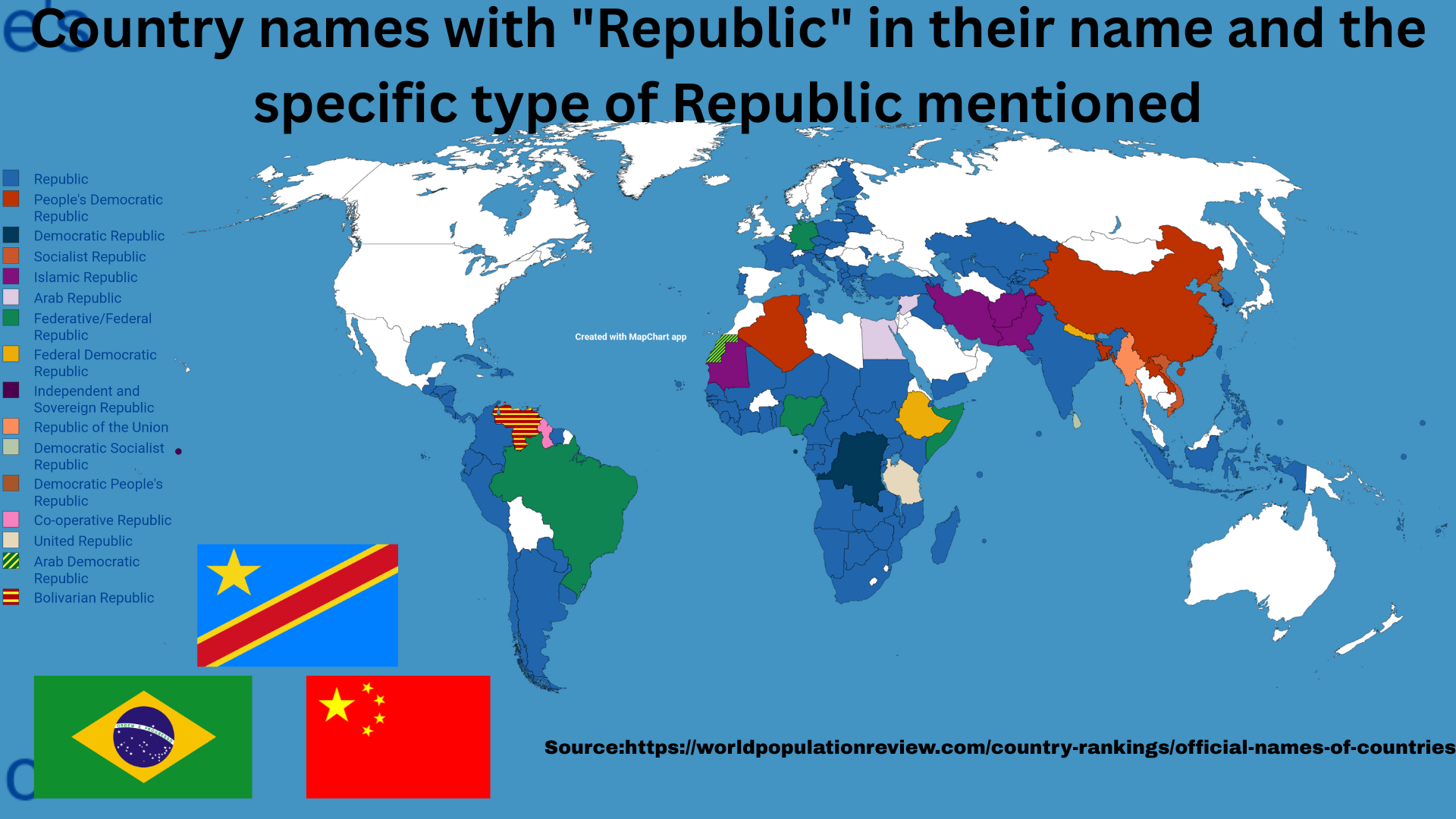Countries with 'Republic' in Their Names Map


Alex Cartwright
Senior Cartographer & GIS Specialist
Alex Cartwright is a renowned cartographer and geographic information systems specialist with over 15 years of experience in spatial analysis and data...
Geographic Analysis
What This Map Shows
This map vividly illustrates the countries around the globe that incorporate the term 'Republic' in their official names, categorizing them by the type of republic they represent. From the well-known French Republic to lesser-known entities, this visualization offers a fascinating glimpse into how nations identify themselves through this political designation.
Interestingly, the term 'republic' has its roots in Latin, meaning 'public matter,' and signifies a form of government in which the country is considered a 'public matter,' and thus, officials are accountable to the public. This map allows us to explore the diversity of governance styles and political frameworks that exist under this unifying term, showcasing how different nations interpret the concept of a republic.
Deep Dive into Republics
Republics can be broadly categorized into several types, including presidential, parliamentary, and federal republics. Each type varies significantly in governance and political structure, which can reflect the country's history, culture, and societal needs.
**Presidential Republics** are characterized by a strong executive branch led by a president. Countries such as the United States of America, Colombia, and Brazil exemplify this model. In these nations, the president acts as both the head of state and government, wielding significant powers, including the ability to shape foreign and domestic policies. For instance, the United States has a long-standing tradition of a presidential system that has influenced many other nations around the world.
**Parliamentary Republics**, on the other hand, blend the executive and legislative branches more closely. In countries like India, Italy, and Israel, the prime minister is often the leader of the majority party in parliament and is accountable to the legislative body. This system can lead to a more dynamic political environment, where the government may change hands more frequently based on parliamentary votes.
Then there are **Federal Republics**, such as Germany and Nigeria. These countries are divided into states or provinces that have their own governments, while still recognizing a central federal government. This structure allows for a distribution of power and can help manage diverse populations with varying needs and interests.
Interestingly, some nations have adopted hybrid systems that combine elements of different republic types. For example, the Russian Federation operates under a federal structure but is often criticized for its strong presidential control, blurring the lines typically seen between presidential and parliamentary systems.
Understanding these distinctions is crucial as they influence everything from policy-making to civil rights. The governance style can affect citizens' lives significantly, impacting everything from economic stability to social freedoms.
Regional Analysis
Looking at the countries represented on the map, we can see diverse applications of the republican model across different regions. In Europe, many countries like France, Italy, and Germany showcase strong parliamentary systems that emphasize coalition-building and consensus. In contrast, the Americas present a more varied picture, with both presidential (like the U.S. and Brazil) and parliamentary systems (like Canada) coexisting.
Africa is particularly interesting, as several nations have adopted republican frameworks post-colonization, but the effectiveness of these systems often varies significantly. For instance, South Africa’s parliamentary system has been relatively stable since the end of apartheid, yet others like Zimbabwe and Sudan have faced challenges in governance that have undermined their republican structures.
In Asia, the map highlights both parliamentary republics like India and federal republics like Afghanistan, each dealing with unique challenges shaped by their historical contexts and socio-political landscapes. The complexities of governance in these regions often reflect their colonial pasts and the ongoing struggles for democracy and representation.
Significance and Impact
The significance of republics in today's world cannot be overstated. They represent a commitment to democratic principles, accountability, and the rule of law. However, the effectiveness of these systems can vary greatly. Some republics are thriving democracies, while others struggle with issues of corruption, authoritarianism, and civil unrest.
Moreover, the trend towards republicanism continues to evolve. As more countries transition from authoritarian regimes to democratic governance, the model of a republic is often seen as a desirable goal. However, the path to achieving an effective republic can be fraught with challenges, as seen in numerous case studies around the globe.
Looking forward, it's essential to monitor how these republics adapt to changing political landscapes, including the rise of populism, the impact of globalization, and the ongoing fight for human rights. The future of republics will likely hinge on their ability to remain responsive to their citizens’ needs while upholding democratic values.
In conclusion, the map of countries with 'Republic' in their names offers not only a visual representation but also a window into the diverse political realities that shape our world today. Understanding these distinctions is crucial for anyone looking to grasp the complexities of global governance.
Visualization Details
- Published
- August 12, 2025
- Views
- 110
Comments
Loading comments...